Why Are Scientific Papers So Hard to Read
How To Read Scientific Papers
Increase your efficiency with the three-pass arroyo
![]()

Goal of this commodity
This article should serve as a rough guide on how to read a scientific newspaper because this skill is rarely taught at Universities and tin can pb to massive frustrations. Most of the fourth dimension it is causeless that students already know some methods on how to read enquiry papers but I have to admit that I knew none of them in the first.
When I had to read my start papers, I j ust started to read them from the beginning to the end. Similar a volume. I looked at every table, figure and math equation, and tried to make sense out of information technology. I wanted to understand it all and do non miss one single piece of information! It only so happens that at that place is a fitting term for that: the fear of missing out (FOMO). Simply when I came to the end after several hours of frustration and background reading, I realized that the paper was not as helpful every bit I idea in the outset. And I already forgot about the big picture or never had information technology in the showtime place. I got lost in details. Not a very effective way of reading a paper, especially when y'all are doing a literature survey or just have to read multiple papers in a day.
Just it seems like there is a better way on how to arroyo this trouble: the 3-laissez passer arroyo.
The residual of this article is structured like this and explains each topic in greater particular:
- The three-pass approach (tl;dr)
- The outset pass: The bird's-centre view
- The second pass: Grasp the content
- The tertiary pass: Most re-implement the newspaper
- Doing a Literature Survey
- Optional extensions
- Little boxes
- Highlighters
- Mindmaps
- Pomodoro sessions
- The Feynman technique and safety duck debugging
- Parkinson's law and the Pareto principle
The iii-pass approach (tl;dr)
In "How to Read a Paper"[1] past Srinivasan Keshav, he describes the three-laissez passer approach which acts as a filtering system. It is an iterative and incremental way of reading a paper. This deductive method goes from a general overview to the specific details while each step takes more than time than the previous one and gives you deeper insights in each iteration.
- The first pass: Here you become the bird's-heart view or "the big film" of the paper. This stride usually takes 5 to 10 minutes. You skim through the construction of the newspaper and ignore any details similar math equations only you should read the abstruse, championship, introduction and conclusions entirely. This step serves as a outset bank check if the paper is worth reading in general. By post-obit this approach you can already discard papers which are non helpful, due east.g., in a literature review.
- The second pass: Hither you try to sympathise the content of the paper past reading it as a whole. This footstep can take up to 1 hour. You tin withal ignore details similar math equations simply try to make some notes at the margins and write down key points. Try to rephrase the fundamental points in your ain words.
- The third pass: You accept to be very sure that this paper is worth your time earlier continuing with this step because it can take up to 5 hours as a beginner. More than experienced readers may be able to finish this pace in 1 hour. Now is the fourth dimension to read the complete paper with all its math equations and details. Try to almost re-implement the paper or use any tools you like to recreate the results. If y'all are a reviewer then you probably take to take this step to give detailed feedback.
I would similar to bespeak out that this commodity is not about reviewing papers. However, if you are searching for whatsoever reviewing guidelines then take a look at the references at the end of this article [ii],[three],[4].
The following sections describe each stride of the iii-pass approach in greater particular.
The first laissez passer: The bird's-eye view
"The first laissez passer is a quick scan to go a bird's-eye view of the newspaper." — Srinivasan Keshav
The goal of the start pass is to get the big picture of the newspaper and should not take longer than 10 minutes. You lot don't take to go into the details or even read the paper in its entirety.
Glance over the paper and see how it is structured. Look at the sections and sub-sections but ignore their content. While you are reading the sections and sub-sections, you are already priming your brain for the upcoming content and you lot may already come upward with some vague questions in your head. This will brand information technology easier for you to spot important or interesting passages later on if you decide to get farther.
While y'all only glance over the construction you should read the following sections completely:
- Abstruse
- Championship
- Introduction
- Conclusions
These sections will give you enough information so that you know what the paper is most and if it's worth reading whatsoever further. While reading these sections you could also have a look at the references and see if something seems familiar to you or if something has already been mentioned in other papers you have read earlier.
At the terminate the first pass you should be able to answer the so-called "five C's" as Keshav[1] puts it:
- Category: The category describes the type of the paper. Is this paper almost a epitome? About a new optimization method? Is it a literature survey?
- Context: The context puts the newspaper into perspective to other papers. What other papers are related to this one? Tin can you connect it to something else? You could as well see the context as a semantic tree where you assign specific importance to the paper. Is it an important branch or an uninteresting leaf? Maybe you exercise not have any prior knowledge in this field and therefore yous still accept to build your semantic tree from the ground up. This tin can be demotivating in the beginning but it is normal.
- Correctness: Correctness is, just every bit the name suggests, a validity measurement. Are the assumptions valid? Near of the time the showtime laissez passer won't give you plenty information to answer this question with certainty but you lot probably have a hunch which is enough in the offset.
- Contributions: About papers have a list of their contributions correct in the introduction section. Are these contributions meaningful? Are they useful? Which problems do they solve? Are these contributions novel?
- Clarity: Based on the sections y'all just read, do you think that the paper is well written? Did yous spot any grammar mistakes? Whatever typos?
This pass should serve as a quick, starting time filter. When yous are done with the first pass y'all tin decide to read further and continue with the 2nd pass or you decide non to read farther because:
- You are defective background information
- You don't know enough about this topic
- The paper does not involvement y'all or is non benign to you
- The paper is poorly written
- The authors brand faux assumptions
If that paper lies non in your surface area of expertise but may become relevant to you at a later point so this first pass is sufficient and y'all probably do not have to continue reading. If that's not the example so y'all can continue with the 2nd pass.
The second pass: Grasp the content
"Sometimes you won't understand a paper even at the terminate of the second pass." — Srinivasan Keshav
The second pass can terminal upward to 1 hour and here you should read the consummate paper. Ignore details such as proofs or equations because most of the time you won't demand that specific knowledge anyway and it costs you lot valuable time. Take some notes at the margins of the newspaper and write down the key points. Writing down little summaries or fundamental points at the margins in your own words is a smashing way to come across if you lot actually understand what you've only read; and you will call back it manner longer.
Await at whatsoever type of illustration in the paper like tables and figures and see if you lot tin spot any mistakes or discrepancies. Exercise the illustrations brand sense? What kind of information practice they convey? Are the axes properly labeled? Do the figures and tables accept proper captions? Sloppy work like this can already be a strong indicator of an overall badly written newspaper.
You can already mark relevant unread references for further reading which is a skillful manner to learn more about the groundwork. Build your semantic tree and see which papers are important branches and which ones are unimportant leaves.
At the end of the second pass it can happen that you notwithstanding don't understand what y'all've just read. This could be due to many reasons. Maybe this is not your field of expertise or y'all are defective groundwork information. Practise not experience discouraged because this happens all the fourth dimension; even to Professors… so I was told.
Proceed in listen that research groups oftentimes spent several months or even years to bear their research. And now they had to compress their results and cognition into a paper which may be had to run into certain requirements to get accepted by a conference, e.m., a certain page count. If you think nearly it that manner, and so it does experience way less demotivating when you did not empathise everything in ane hour.
It sometimes helps when you write down what you lot did not understand. Then you take a smashing starting point to make full in the knowledge gaps later on through some groundwork reading.
You now have different options available to you:
- Yous can stop reading whatsoever further considering the paper is non benign to yous out of several reasons
- Put the newspaper bated and continue reading afterwards you read some background fabric
- Continue with the third pass
The 3rd laissez passer: Virtually re-implement the paper
"This pass requires great attention to item. Y'all should identify and challenge every assumption in every argument." — Srinivasan Keshav
If you are a beginner and then this laissez passer probably takes 4 to 5 hours. This is a lot of work and you should carefully consider if this step is worth your time. On the other mitt, if y'all are already an experienced reader so this footstep may only take you i hour. This step is mandatory if you lot are a designated reviewer or you already know for sure that you accept to understand the paper with all its details.
Read the paper in its entirety and question every detail. Now it's fourth dimension to go into the nitty-gritty math equations and trying to encompass what is going on. Make the same assumptions as the authors and re-create the work from scratch. You can well-nigh re-implement the steps in your head or use any tool that you may deem fit. Use a slice of paper and depict a flowchart of the different steps or use pseudo-code. It'south really upwardly to you. Nigh of the time I'g reading papers related to Artificial Intelligence and Computer Science and therefore information technology makes sense to re-implement things in raw Python or utilize Jupyter Notebooks. Information technology actually depends on your field.
At the end of this pass y'all should be an adept and know the paper's strong and weak points. You can make statements about missing citations and potential issues. You lot can reconstruct the structure and explain to someone in simple language what the newspaper is all about.
The concept of learning past teaching others is chosen the "Feynman technique" and is a great fashion to discover whatsoever gaps in your understanding.
Doing a Literature Survey
Doing a literature survey is a bit different than reading a single paper but you can still apply the three-laissez passer arroyo.
Starting time pass
In the first pass you have to collect potentially useful papers. You can employ a search engine like Google Scholar and type in keywords to find iii to 5 recent papers. What I usually do is to create a simple list of papers clustered by their topic together with the publishing year and the count of citations. The citation count is usually a good indicator of a paper is important. Just typing in your keywords into Google tin can also lead to surprisingly well results.
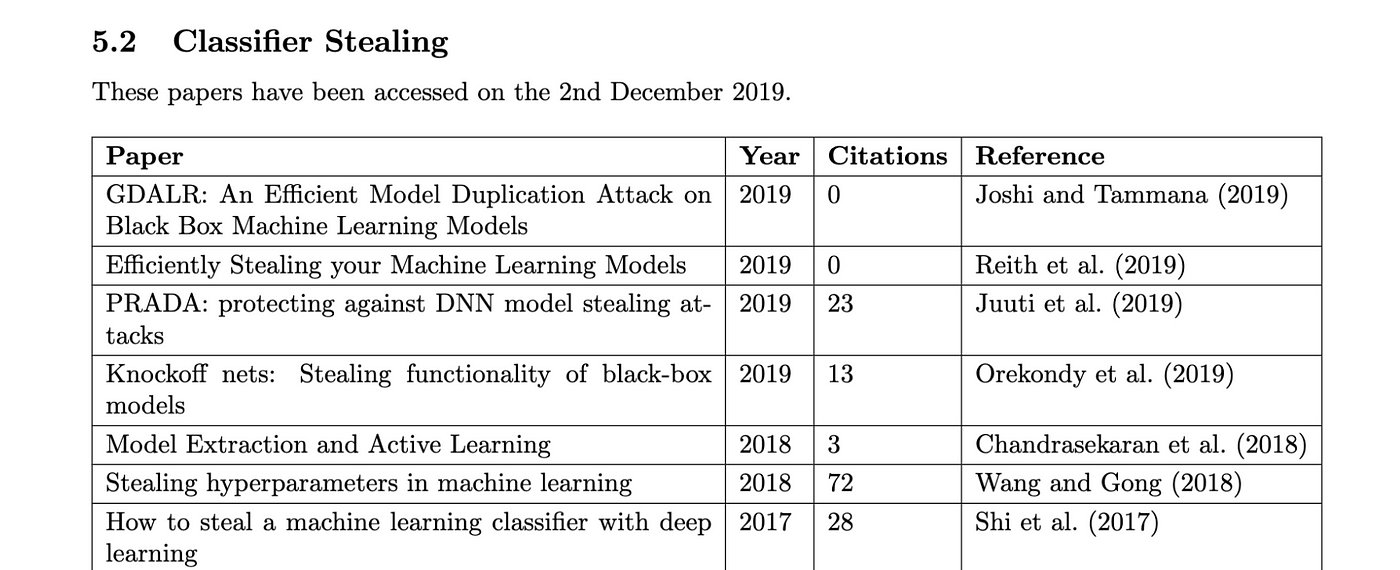
When you have your fiddling collection of initial papers ready, you tin can go on with the usual first-pass on each of them to become the large picture. You tin also skim through the references to see if the papers take any citations in common. Common citations are good candidates to include in your survey.
2nd laissez passer
When you identified mutual citations and repeated authors, you tin can visit their websites and run across if you can spot whatsoever recent work. Also download the commonly cited papers and apply the three-pass approach for unmarried papers again.
Third pass
Here y'all can try to visit the websites of the peak conferences or journals and look through the recent proceedings. Try to identify related high-quality work and employ the 3-pass approach for single papers again.
Optional extensions
Keep in listen that these optional steps might add together some time to the iii-laissez passer arroyo. They might not be beneficial to you if you are just skimming through papers to see if they are helpful or non. On the other hand, if you already know that you have to read and understand the newspaper in its entirety and at that place is no way effectually it, and so these steps might help you too. These are my personal practices and I'thousand constantly trying to improve them.
Piddling boxes
When you lot take a look at the following picture, you can run across that I surrounded math equations, figures and tables with boxes. I similar to wait at papers in terms of clearly separated boxes and separate the text from the rest. I unremarkably do this during the first-pass while I'1000 skimming through the paper. This helps me to quantify how many details in terms of math equations I can expect later on on and it just seems more than pleasant to my optics.
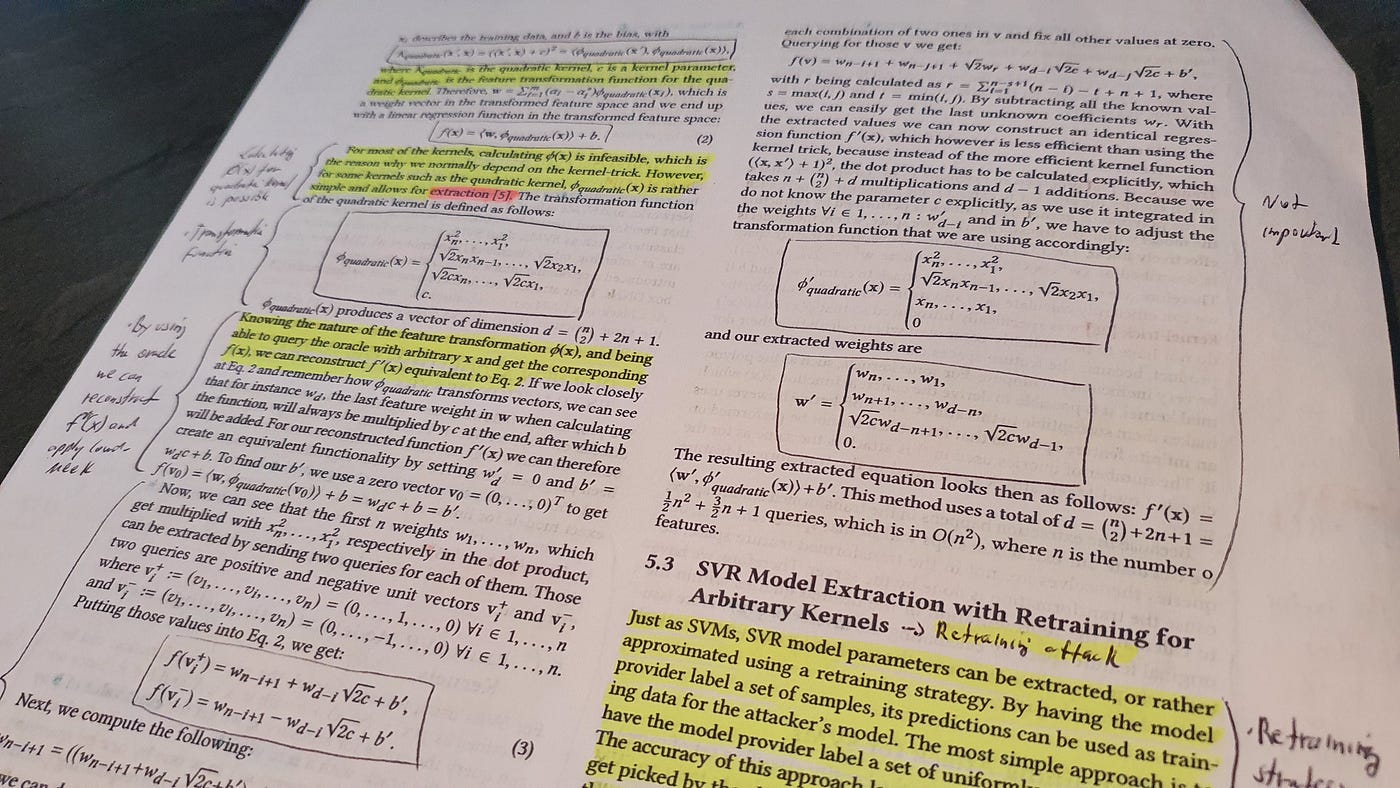
Highlighters
Highlighters are a great tool to mark sections in your paper and give them distinctive meanings. You can attempt to come up with your own highlighting system or use an existing one. Try to give every color a distinctive meaning and stick to it.
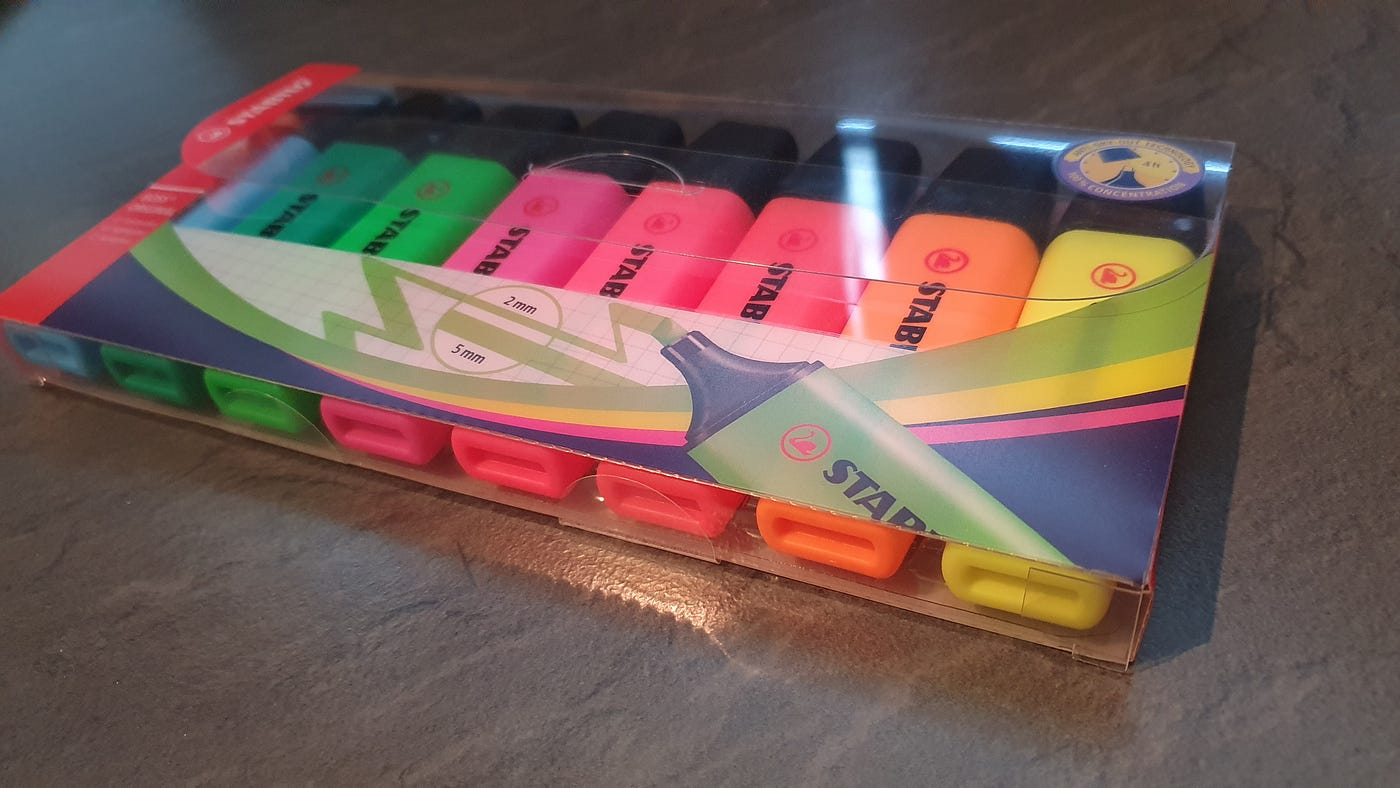
During the second-laissez passer, I usually use yellow for interesting or important sentences. Orangish is for citations and green for definitions or catchphrases. Nevertheless, feel free to utilise whatever organization y'all may please. Proceed in mind that highlighting does not supervene upon annotation-taking! During the 2d-pass you tin can take notes at the margins, draw picayune diagrams for better understanding and utilize highlighters in combination.
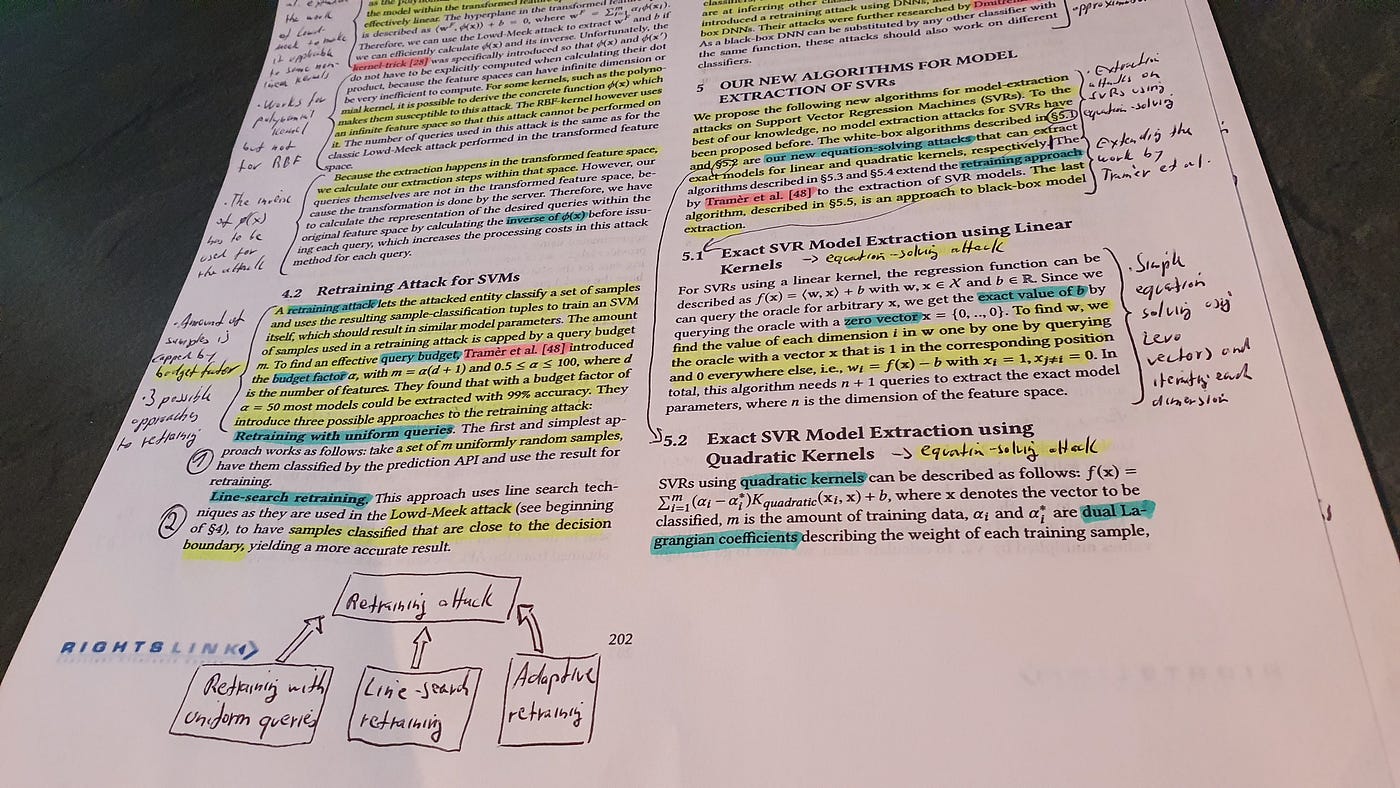
Interesting or important references at the end of the paper get the same color every bit before.
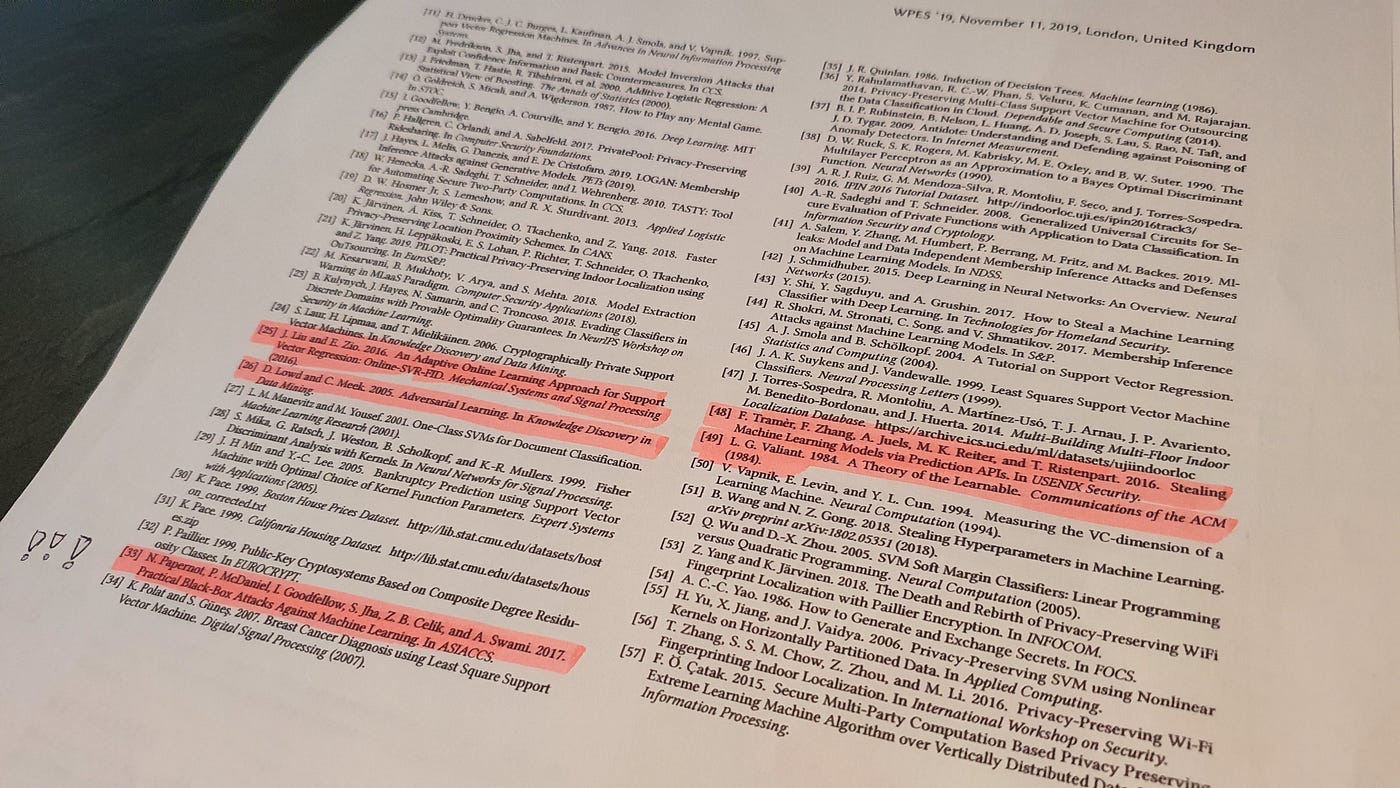
Mindmaps
If yous are more visual and want to get a better overview of the paper, mind maps may exist a suitable fit. At that place are no strict rules in creating mind maps and I just started with the title of the paper in the center. Big arrows are pointing to the main section titles and are highlighted with orange. These are the big branches. Start-level subsections are highlighted with green. Anything else gets no highlighting. Feel gratuitous to come with your own arrangement.
This footstep usually adds 25 minutes to the first-pass and I'm still not certain if information technology is worth the fourth dimension. On the other hand, if yous continue to the 2nd-pass and want to write down an of import annotation, you can put that straight into the corresponding node of the mind map. This may assist you to get the large picture more visually. This may also be a faster style to refresh your memory about a paper later on some time has passed.
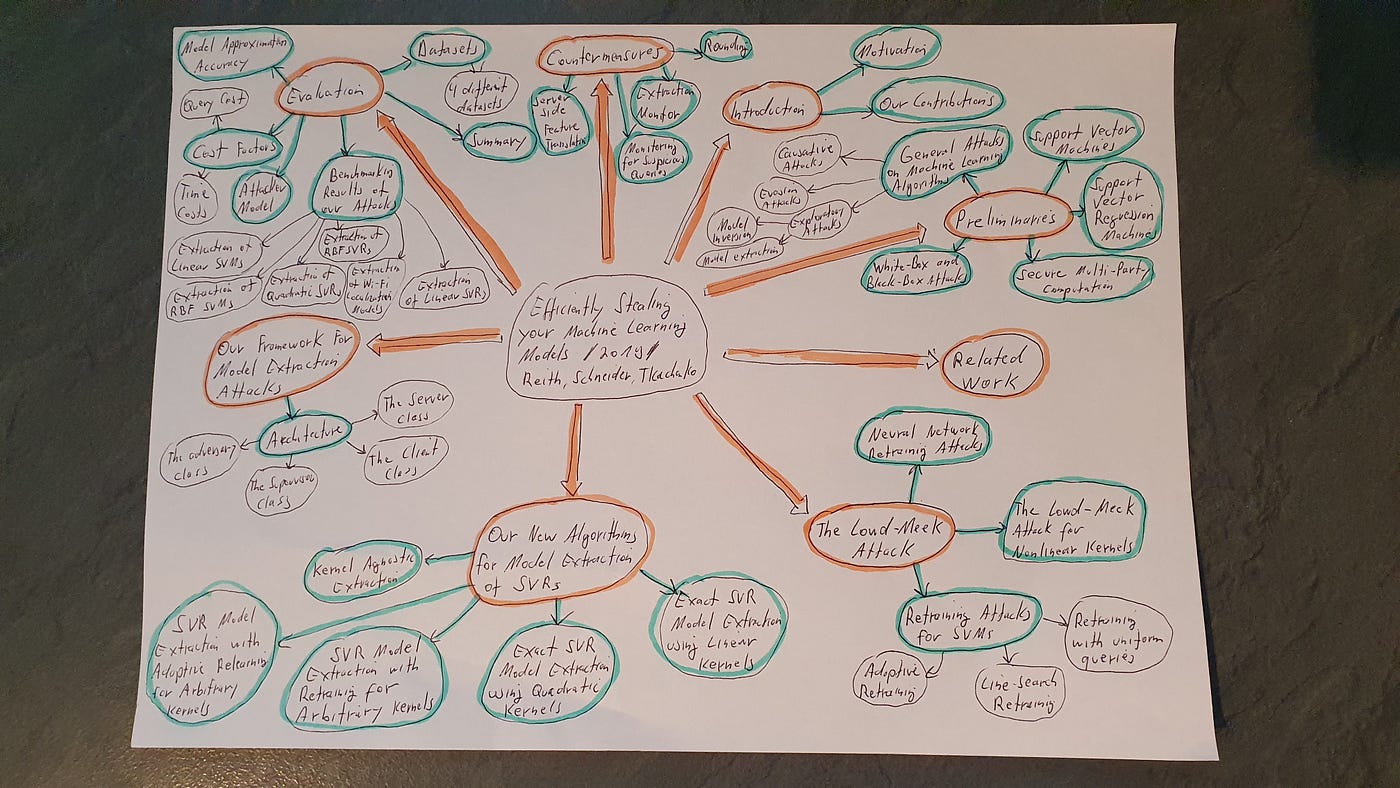
Pomodoro sessions
The Pomodoro technique[5] is a great tool if you are lacking motivation. Sometimes information technology's not the case that you practice not know how to read a paper only more than that you experience intimidated by it and lack the motivation to even get started. Procrastination kicks in and you are missing an important deadline for a review.
Get a timer and gear up it to 25 minutes. Do not expect whatever results. Just set it to 25 minutes and showtime. Eliminate whatever distractions and follow the three-pass arroyo until the 25 minutes are up. You may non cease the whole iii-laissez passer approach but at the end of the 25 minutes you will likely be surprised what you lot accomplished. You now know what the newspaper is about and you probably feel less intimidated. You probably feel like yous could set the timer for some other 25 minutes.
By using this timeboxing arroyo you gain momentum and tin follow the three-pass approach more easily. The overnice thing is: you can employ the Pomodoro technique to whatever task.
The Feynman technique and safe duck debugging
As mentioned earlier, the Feynman learning technique is a neat tool to spot gaps in your agreement. The full general steps are:
- Choose a concept y'all want to learn and write its name at the top of a piece of paper.
- Pretend you are teaching the concept to someone who has no prior knowledge near it. Try to utilise unproblematic linguistic communication and exercise non merely recite. Use your own words!
- Review your explanation. Was is accurate despite the usage of uncomplicated language? Identify weak points in your explanation and write it on the slice of newspaper. Get back to your learning material and see if you tin clarify these points.
- Simplify your caption if you used lots of technical terms or complex language in areas of your explanation.
If you lot want to utilise the Feynman technique simply don't have a petty brother at manus for step 2, and so the rubber duck may be for you.
The idea backside safety duck debugging has its roots in Software Engineering and first occurred in the book The Pragmatic Programmer by Andrew Hunt and David Thomas. In the book, a programmer carries around a rubber duck and explains the lawmaking, line-by-line, to the duck to spot any mistakes. You tin also use any other object for this. Do you lot accept a cat? I'm sure she always wanted to know how Hamiltonian Monte Carlo sampling [six] works.
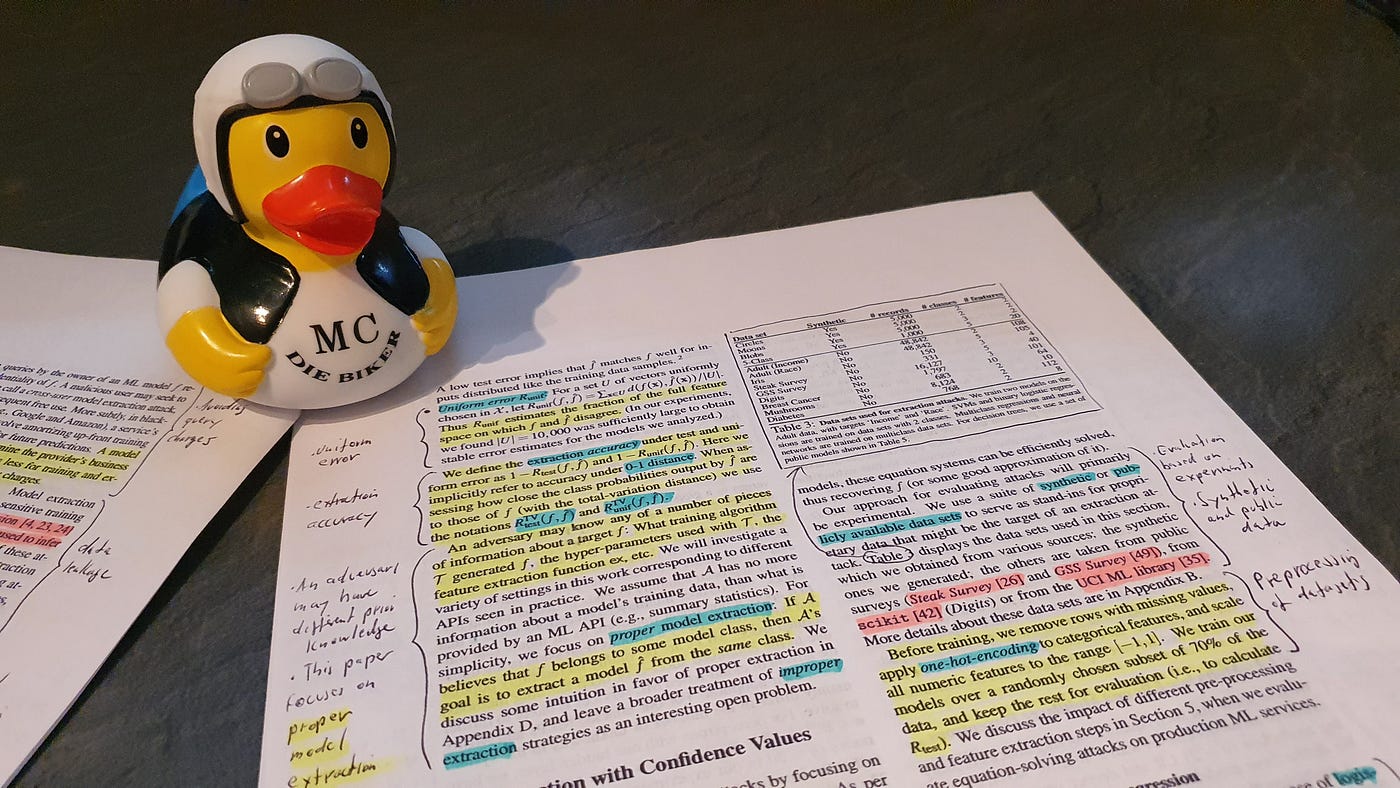
Parkinson's law and the Pareto principle
The following two approaches are not just express to the task of reading papers only to whatever other task in general. If you combine these two then you come upward with a capped timebox approach, e.g., programme x Pomodoro sessions for the whole paper and then stop. You lot can also try to give yourself a totally unrealistic timeframe to read a paper then check your progress.
Parkinson's law states the following:
"Work expands so as to fill the time bachelor for its completion" — Cyril Northcote Parkinson
If you lot plan x hours to read a paper, taking notes, writing summaries and so forth, and so information technology will probably have yous 10 hours.
The Pareto principle (also called the 80/20 dominion) on the other hand states:
"For many events, roughly 80% of the furnishings come up from twenty% of the causes." — Vilfredo Pareto
This means that information technology takes y'all probably xx% of your overall attempt and time to empathize lxxx% of the newspaper. This eighty/20 split is non fixed only is rather a rough approximate. It could also be something like seventy/thirty.
Did you ever approach a deadline where you were left with 30 minutes to do a task that you thought would take you a couple of hours? And and then you realized that you actually did quite well? Parkinson's law forced you into a 30-minute timeframe and the Pareto principle ensured that you lot simply did the tasks which contributed the most to your terminal result. Try to simulate this situation past giving yourself unrealistic, tight deadlines.
I hope you enjoyed this article and I could help you during your bookish journey.
Are you interested in upcoming updates about my articles or projects? My newsletter keeps you upwards-to-engagement one time per month!
If you desire to support me and you're not withal a medium member, then please consider signing up through my referral page: https://medium.com/@christoph.schmidl/membership
References
[one] Keshav, S. (Srinivasan)(2007). How to read a paper. ACM SIGCOMM Figurer Advice Review, 37(3), 83–84. (URL: https://dl.acm.org/doi/pdf/10.1145/1273445.1273458)
[2] Cormode, G. (2009). How non to review a newspaper: The tools and techniques of the adversarial reviewer. ACM SIGMOD Tape, 37(4), 100–104. (URL: https://dl.acm.org/doi/pdf/ten.1145/1519103.1519122)
[3] Meier, A. (1992). How to review a technical paper. Free energy and Buildings, nineteen(1), 75–78. (URL: https://eta-intranet.lbl.gov/sites/default/files/how-to-review-a-technical-paper_0.pdf)
[4] Roscoe, T. (2007). Writing reviews for systems conferences. (URL: https://www.cl.cam.ac.united kingdom/teaching/1011/R01/review-writing.pdf)
[v] Cirillo, F. (2018). The Pomodoro Technique: The Life-Changing Time-Direction System. Random House.
[six] Betancourt, M. (2017). A conceptual introduction to Hamiltonian Monte Carlo. arXiv preprint arXiv:1701.02434. (URL: https://arxiv.org/pdf/1701.02434.pdf)
Source: https://towardsdatascience.com/how-to-read-scientific-papers-df3afd454179